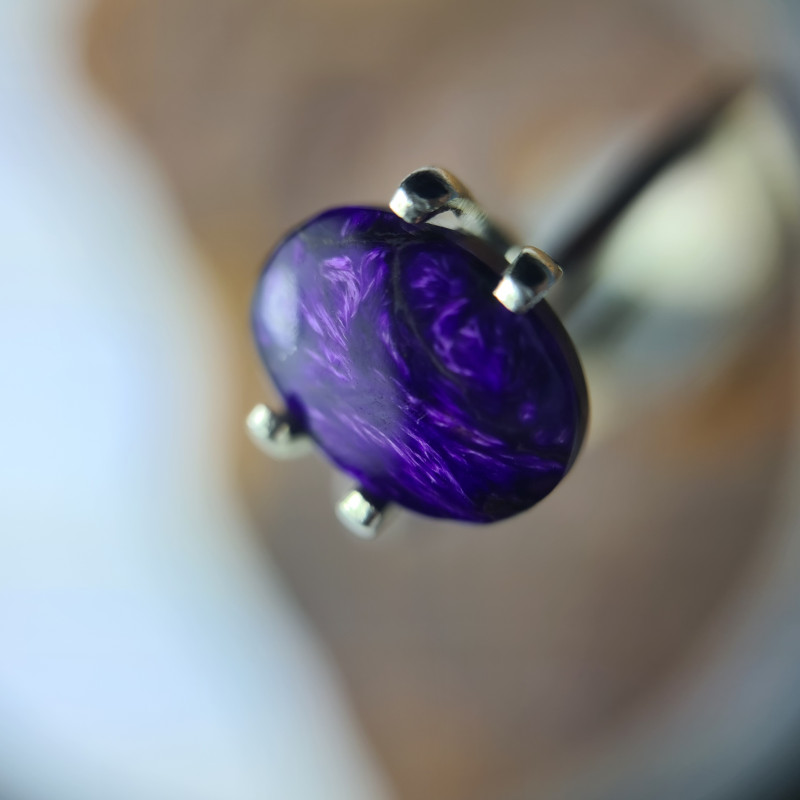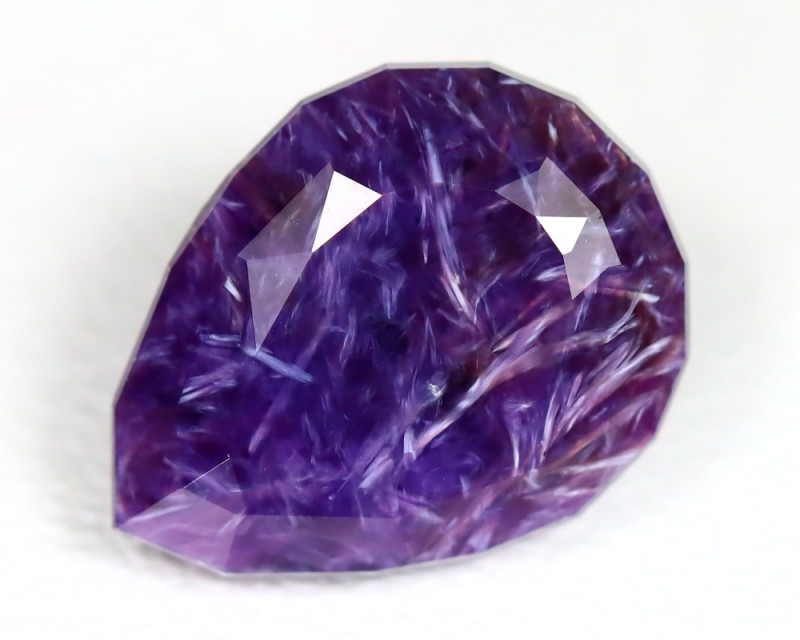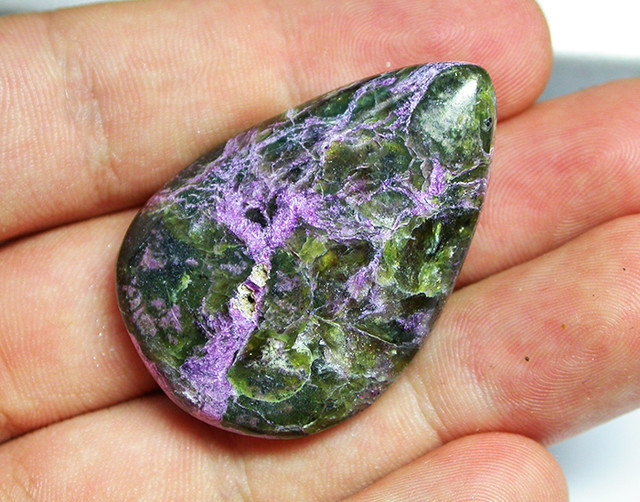
Stichtite Gemstone: Properties, Meanings, Value & More
 Stichtite is a soft, pink to lilac or purple gemstone. Most often, you’ll see stichtite in serpentine, creating a green, black, and pink to purple stone commonly sold under the trade name “Atlantisite.”
Stichtite is a soft, pink to lilac or purple gemstone. Most often, you’ll see stichtite in serpentine, creating a green, black, and pink to purple stone commonly sold under the trade name “Atlantisite.”
Is stichtite rare? Yes, stichtite is fairly rare. Faceted stichtite gems are incredibly rare, as the stone’s fragile nature makes faceting nearly impossible.
Stichtite joins the bright red gemstone crocoite, another rare find, as the main gemstones found in Tasmania. Both Australian gemstones are rare.
This guide will teach you all about stichtite gemstones, from their properties and prices to history and healing powers.

What Is Stichtite?
Stichtite is a semi-precious gemstone found in pink to purple hues. Purple is a rare color for natural gemstones (though red is the rarest). Though not a traditional birthstone, stichtite is a zodiac stone for Virgo and vibrates with the number 5 in numerology.
One alternate name for stichtite is chrom-brugnatellite, an incorrect name given by German mineralogist Laura Hezner in 1912 before further analysis was done.
Another nickname for stichtite from Tasmania specifically is Tasmanite. However, this name is more often applied to a sedimentary rock containing an algae called Tasmanites or a reddish-brown, translucent material resembling amber.
Back to the stone at hand, let’s get into what sets stichtite apart as a mineral.
Stichtite Specifications & Characteristics
Stichtite is a hydrated chromium magnesium carbonate mineral. The mineral’s formula may be written as Mg6Cr3+2(OH)16[CO3]·4H2O or Mg6Cr2(CO3)(OH)16·4H2O. Iron is a common impurity. Stichtite is often found mixed with chromite, serpentine, or both.
The minerals woodallite and barbertonite are similar to stichtite in both composition and appearance. Woodallite is slightly less dense than stichtite and barbertonite has higher refractive indices than stichtite.
The stichtite mineral itself is very soft, only slightly harder than talc. Like talc, it feels greasy to touch. However, stichtite has a flexible but inelastic tenacity (a measure of mineral resistance to stress or pressure), meaning it can be bent but stays in the new, bent form afterwards. In contrast, talc has a sectile tenacity, so it will break off into thin sheets or flakes.
In terms of its crystal habit, stichtite minerals typically form as massive aggregates of plates or fibers. It can also form as compact masses. This is unusual for carbonate minerals, which mostly occur as well-formed crystals.
Listed below are stichtite’s mineral properties:
Mohs hardness: 1.5-2.5
Color: Shades of purple to pink; Commonly found with green and/or black inclusions
Crystal structure: Hexagonal (trigonal)
Luster: Waxy, greasy, or pearly
Transparency: Translucent to opaque
Refractive index: 1.516-1.545
Density: 2.11-2.16; South African specimens - up to 2.22
Cleavage: Perfect on [0001]
Fracture: Uneven/irregular or flaky
Streak: White to lilac
Luminescence: None
Pleochroism: Present - dark rose-pink/light rose-pink to lilac or light to dark red
Birefringence: 0.024-0.028
 Pictured above: Stichtite in serpentine (Atlantisite)
Pictured above: Stichtite in serpentine (Atlantisite)
Types of Stichtite
The primary type of stichtite is a rock containing stichtite and serpentine. Mineralogists usually just call this rock “stichtite in serpentine,” but a well-known trade name is “Atlantisite.”
It should be noted that the trade name “Atlantisite” is registered to Gerald Pauley for material from Stichtite Hill in Tasmania.
What does Atlantisite look like? Overall, the stone’s dominant hues are green (from serpentine) and purple (from stichtite). The shade of green varies from pastel to dark ivy, and the often-dark purple may appear as veins, knots, or spots. Usually, chromite and magnetite are also present, adding black to the mix.
Another lesser-known type is Bouazzerite, a term used by Tasmanian miners for iron-rich stichtite. However, “bouazzerite” also refers to a different green mineral with the formula Bi6(Mg,Co)11Fe3+14(AsO4)18(OH)4O12·86H2O.
Speaking of distinguishing different stones…
Stichtite vs. Similar Gems
Stichtite can be easily confused with purpurite, sugilite, and charoite. In fact, those three gems are commonly mixed up with each other. But besides being purple, each gem is completely different.
 Pictured above: Purpurite
Pictured above: Purpurite
Stichtite vs. Purpurite:
Purpurite is a manganese phosphate mineral. It has a generally darker and broader color range than stichtite, including brownish black, violet, purple, or dark red. Stichtite can be deep-colored, but it's generally lighter. Purpurite’s crystal system is also orthorhombic, while stichtite is hexagonal.
Plus, purpurite is found in igneous pegmatites, while stichtite is mostly found in metamorphic serpentinites.
 Pictured above: Sugilite
Pictured above: Sugilite
Stichtite vs. Sugilite:
Sugilite is a rare, complex mineral with the formula KNa₂(Fe,Mn,Al)₂Li₃Si₁₂O₃₀. Besides purple, sugilite can be light brownish-yellow, light pink, reddish-violet, or colorless. Sugilite’s purple shades generally have bluer undertones than stichtite.
 Pictured above: Charoite
Pictured above: Charoite
Stichtite vs. Charoite:
“Charoite” refers to a mineral and a rock largely composed of that mineral, but only the rock is used as a gemstone. The gem is set apart by its distinct swirl pattern incorporating white and black, along with its chatoyancy, two traits stichtite lacks.
Overall, you can distinguish stichtite from each of these gems by hardness. On the Mohs mineral hardness scale, stichtite is at a low 1.5-2.5. Meanwhile, charoite ranks 5-6, sugilite ranks 5.5-6, and purpurite ranks 4-4.5.
Enough mineralogy, let’s get into stichtite’s magical properties!
Stichtite Stone Meaning & History
Stichtite symbolizes empathy, forgiveness, and restoration. The stichtite spiritual meaning is associated with love and acceptance in all forms — self-love, love for others, divine love, you name it.
In terms of the Atlantisite or stichtite in serpentine meaning, it represents balance, hope, and the harmony of heaven and earth.
History
Stichtite was first officially discovered in 1910 at the former mining locality of Dundas in Tasmania, Australia. Dundas was a significant mining town historically, but it has since become a ghost town, only inhabited by one couple as of 2017. The area is now part of Zeehan.
Former chief chemist of Mount Lyell Mining and Railway Company A.S. Wesley is credited with making the initial stichtite discovery. The first description, however, came from Tasmanian mineralogist William Frederick Petterd, followed by Wesley’s analysis in 1910.
Wesley named the new mineral after the manager of the Mount Lyell mine, Robert Carl Sticht. Sticht was an American metallurgist famous for developing pyritic copper ore smelting and helping turn the Tasmanian mining site into a self-sustaining area in Queenstown. The Economist even nominated the Mount Lyell mine as the best-managed mine in Australasia.
Additional analyses of the mineral came from German chemist Laura Hezner in 1912 — where she mistakenly called it chrom-brugnatellite — and American geologist William Frederick Foshag in 1920.
Tasmania was the only known source of stichtite until specimens were found in Barberton, Ohio, USA, described by American geologist Alfred Lewis Hall in 1922. Another occurrence in Scotland showed up soon after, described by English geologist Herbert Harold Read and B.E. Dixon in 1933.
That covers the history, now what is stichtite good for?

Stichtite Healing Properties
Both stichtite and Atlantisite are healing stones. Like other purple gemstones, stichtite inherently brings wisdom and spiritual awareness.
Pink stichtite joins other pink gems in promoting love and acceptance, while the green gemstone serpentine in Atlantisite offers luck and renewal.
Physical Healing
Physically, stichtite is said to help with issues related to the spine and brain, such as dementia, ADHD, and executive dysfunction.
Emotional Healing
Emotionally, stichtite can benefit those in need of grounding, relaxation, and self-love. It’s said to encourage healthy relationships, promote inner peace, and dispel worries. Stichtite is also believed to help you recover from intense times of stress or change.
Chakra Healing
Chakra healing involves balancing one or more of the seven energy centers (chakras) along your body to resolve negative symptoms associated with blockages.
Stichtite and Atlansite are crown chakra stones, opening the energy center to bring you the highest spiritual awareness and communication possible.
Stichtite Gemstone Properties
Stichtite value grading isn’t as traditional as other stones, since it’s usually not faceted into gems. However, we’ll still go over some of the standard value factors and how they relate to stichtite below.
Color: Most material leans purple, though some is pink. The shade is typically lighter, but can be deep. Green and yellow splashes are great in Atlantisite, but too many black and brown inclusions can lower value. Higher saturation is better.
Cut: Since it’s not suited to being faceted, most stichtite is cut into cabochons or carved. Carvings range from pendants to household items like bookends.
Transparency: Most stichtite stones are opaque, so rare translucent specimens may carry higher value.
Carat Weight: Despite its rarity, large masses of stichtite can be found.
Speaking of finding masses, how does stichtite form?

Stichtite Formation & Sources
More often than not, stichtite forms as stichtite in serpentine rather than on its own.
The formation process starts when igneous rocks undergo metamorphism, changing into metamorphic serpentinite. Chromite minerals inside the rock become altered into stichtite. You can also find stichtite in igneous rocks, though.
Mining Locations
Since the first discovery there, Tasmania has remained the top source for stichtite gems. Other notable sources are:
Algeria
Brazil
Canada
India
Morocco
Russia
Scotland
South Africa
Sweden
Zimbabwe
Technically, Atlansite can only come from the Stichtite Hill mine in Tasmania, but a few of the locales listed above produce similar stichtite in serpentine stones.

Stichtite Price & Value
Good news for buyers: stichtite is an affordable gem, especially at wholesale sites like Gem Rock Auctions where stichtite is almost always under $1 per carat.
Stichtite cabochons range from $22 to $180, or around $0.40-$0.90 per carat.
Rough stichtite specimens go for $10 to $30, or roughly $0.08-$0.40 per carat. Rough serpentine stichtite ranges from $15 to $190, or around $0.04-$1.15 per carat.
Stichtite jewelry prices range more broadly, with pendants going for around $10 to $125 and rings ranging from $15 to $180.
Before we wrap up, let’s discuss gemstone care.
Stichtite Care and Maintenance
Stichtite is an incredibly soft stone, so it’s crucial to be gentle while handling it. We recommend protective settings for any stichtite jewelry.
You can carefully clean it with a soft toothbrush or cloth, warm water, and mild soap. Keep it away from mechanical cleaning systems, bleach, and any acids. It will dissolve in acids.
Store separately from other gems to avoid scratches.

Stuck on Stichtite Stones?
Whether you love purple stones, green stones, or rare Australian gems, stichtite might just be the stone for you. Its Atlantisite variety is a unique gem that brings grounding green energies with spiritual purples, a true embodiment of heaven on earth!
Search the Gemstone Encyclopedia
Related Auctions
Related Articles
Originally the Birthstones or gemstones were associated with a zodiac sign or the month of a individuals birth. Find out what your stone is and view the stones we have for sale
8th Feb 2021
There are dozens of quartz and chalcedony gems with various colors and patterns. Learn all about quartz properties and every type of quartz, from amethyst and agate to plasma and phantom quartz!
15th Oct 2020
Hackmanite is a pink to violet sodalite gem known for its unique color-change and luminescence. Learn why hackmanite is special, from its rare qualities to the types of hackmanite jewelry available.
28th Mar 2018
Latest Articles
Catapleiite is a lesser-known mineral and rare gemstone often found as stunning tabular rosettes near other rare stones. Discover the history, prices, benefits, and properties of catapleiite!
28th Apr 2025
Yugawaralite is a rare colorless, white, or pinkish zeolite crystal named for its discovery in Yugawara, Japan. Here we uncover the multifaceted history, properties, prices, and uses of yugawaralite.
24th Mar 2025
Simpsonite is a lesser-known mineral known on the gem market for its durability, yellow-orange color, and rarity. Discover all the properties, uses, prices, and history of simpsonite.
3rd Mar 2025
Article Categories
How To's is where you will find helpful articles from gem Rock Auctions on how to cut gemstones, select gemstones and buy gemstones.
9 Articles




